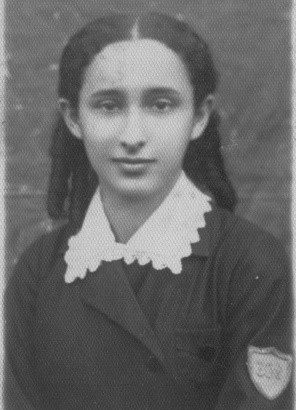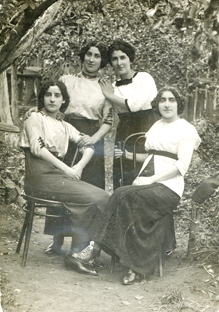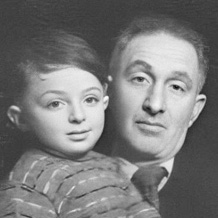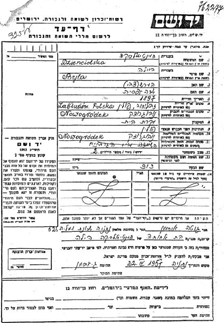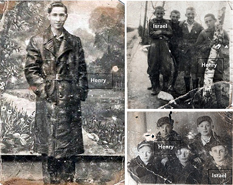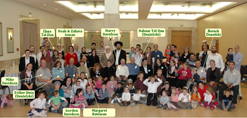by Noah Isman
Preface
This story is about a miraculous family reunion that occurred after sixty-eight years. The prime facilitators of this reunion are no doubt the Yad Vashem Institute that established the Testimony Pages project, the JewishGen organization, and the Internet which made all the information so easily accessible. However, none of it would have happened were it not for one woman who, as early as 1957, meticulously filled in the testimony pages commemorating all her family members who perished in the Holocaust, and one devoted man who relentlessly investigated in order to unearth the roots of his father’s family, and who did not give up regardless of the many dead ends he encountered.
The Family
Hersch and Sarah-Pesia Waniewski, a Jewish couple, lived in Zabludow, a small town near Bialystok in north-east Poland. They had two sons, Zelig and Chaim-Zeidke, and five daughters, Shifra, Raine, Rivka, Beile, and Guta. Zelig and Chaim-Zeidke got married, had children, and continued living in Zabludow. Shifra and Raine immigrated to the USA before WWII (where they became Sophie Ostroff and Raine Miller, respectively). Guta died in 1919, apparently after giving birth to a daughter, Rivka-Esther, who was born that year. Rivka-Esther and her father, also immigrated to the USA before the war (where she eventually became Rebeca-Betty Kahanowitz). All other brothers and sisters remained in Poland. Needless to say, all of them, their spouses and offspring, were Jewish.
Beile married David-Shmuel Dzienciolski. Their first son Henryk (Hersch) was born in 1923 and his brother Zigmond (Israel) in 1924. In 1927 they moved to Bialystok and in 1929 moved farther east to Novogrudok (then in Poland, now in Belarus), where they eventually settled. David was, apparently, not religious, but the family maintained their Jewish identity and was part of the Jewish community.
Rivka married Noah Feder. Their daughter Guta was born in 1924 and their son Zalman-Leib in 1925. Noah was an accountant and Guta used to assist him in his work while she was still attending elementary school. In 1939 she graduated from a trade school in Bialystok and then worked as an accountant while still a teenager. Her professional experience would later help her survive the wartime hardships.
During the Holocaust most family members who stayed in Europe were murdered or otherwise found their death. David, Hersch, Israel, and Guta, who are at the focus of this story, were the only survivors.
Early History
In 1939 Nazi Germany and the USSR signed the Molotov-Ribbentrop Pact that divided Poland and then occupied its territory. Luckily, Novogrudok was in the Soviet part, as the Nazis immediately started to murder the Jews in theirs. The Soviet communist regime, being very oppressive in many ways, also changed the names of places, institutions, and even surnames to suit their policies. Hence, Dzienciolski, being a Polish name and apparently also difficult to pronounce in Russian, was modified to Dentelski. However, in June 1941 the Nazi’s broke the pact and, as part of the Barbarossa campaign, attacked the USSR and started to move east towards Novogrudok. At the time, it did not scare the Jews in Novogrudok, as they considered the Germans as more “civilized” than the Russians (at the time, the Nazi atrocities were not yet known), but the Jews did have concerns that the Germans might mobilize the men to work for the military. In light of that, the Dentelskis decided that David and Henryk (then about 18 years old) should leave eastbound closer to the Russian zone, while mother Beile with Israel would stay (Israel, then about seventeen years old, was recovering from a minor operation). Later, Beile determined it was better to send away Israel as well; he joined another family who was heading in the same direction.
Many people gathered at the border-crossing but the Russians did not let them pass. While they were waiting, and before Israel had a chance to find and join his father and brother, a German air raid started and the crowd dispersed, some running into a nearby forest and some exploiting the disorder to cross into the Russian zone. In the commotion David and Henryk lost each other, never to meet again.
Beile, who stayed in Novogrudok, was eventually murdered by the Nazis together with all other Jewish residents.
At about the same time, the Germans occupied Zabludow and Bialystok. At the beginning of the occupation, while Nazi rule was not very brutal, a Nazi officer started to show growing interest in Guta, who was a seventeen-year-old pretty girl; Guta’s father, Noah, became extremely anxious about the situation. So, in spite of her young age, Noah decided that Guta should escape towards Russian territory. She left in December 1941, never to see her family again; they were all murdered by the Nazis.
War Time Proceedings
David, Israel, and Henryk separately managed to infiltrate into Russia. They each continued to Samarkand in Uzbekistan, without knowing about each other’s fate. There, Israel somehow managed to re-unite with his father, and they stayed there until the war ended. In Samarkand, Israel and his father were “adopted” by the family of Israel’s future wife Lisa. Unfortunately, although Henryk was also in Samarkand at the very same time, he never became aware of the survival and very close presence of David and Israel.
Guta, after leaving home as a teenager with no possessions at all, wandered for six months surviving by the help of good Russians, and eventually arrived in Gorky (now Nizhny Novgorod). In Gorky she managed to find a job as a deputy chief accountant in a textile factory, but in February 1943 she re-located to Kermine (now Navoiy) in Uzbekistan. At first, she lived with a local woman who kindly let her in, but she was in quite bad shape, as she did not have any means to make a living. As she was looking for work, she came to a silk processing factory, of which the manager happened to be a Russian Jew. After hearing her story, he decided to “adopt” her. He took her to live in his home together with his family and arranged for her a to work as an accountant in the factory that he managed. This apparently saved her life, as she stayed with them and kept her job until the war ended.
In Kermine, Guta became friends with her future first husband, Eliezer (a.k.a Lazer) Isman and his elder brother, Leibish, both of whom were also Jewish Polish refugees. Accidentally, while standing on a train station platform, Guta was lucky to spot her cousin Israel on a stopped train. They had a happy reunion. Israel continued his journey, but they stayed in touch ever since. Guta somehow came to find out that her uncle, Zelig, was in Kolhoz, near the town of Karakul. She visited him and found him in such a terrible condition that she could hardly recognize him. Guta and the Isman brothers tried to help him as much as they could, but he caught malaria and eventually died.
Shortly after arriving in Uzbekistan, Henryk decided to join the Polish “Andres’ Army” that was forming in Uzbekistan in 1941. In spite of his Jewish roots, he started attending the Catholic church on Sundays (he later indicated that he did that because the alternative was to clean the toilets, but perhaps it was because he felt it was safer to assimilate with his Polish soldier mates). In 1942 the Andres’ Army was evacuated from the Soviet Union (Henryk included) and made its way through Iran to Palestine where it was put under the British command. From Palestine they continued to South Africa and then were stationed in Scotland for training. In 1944, after D-day, the soldier Henryk found himself with his unit back in mainland Europe where he served as a courier. He was injured near the Belgian border and was sent back to a hospital in Montrose, Scotland.
After the War
After the war ended, Israel moved to Lvov (now Lviv in the Ukraine) together with Lisa’s family; David settled in Kiev (Ukraine’s capital).
Israel and Lisa got married in 1946, and had two sons, Nahum and Baruch, both born in Lvov. In 1957, following the Gomulka-Khrushchev agreement for repatriating Polish refugees in the USSR, they traveled to Poland and then immigrated to Israel. In Israel they first came to Netanya and joined Guta’s family, who provided them with initial accommodation and assistance. In Netanya, their daughter Esther was born, and a year later they moved to Givatayim, where they lived for the rest of their lives. The families of Guta and Israel stayed in close contact ever since.
David, realizing that his wife Beile had been murdered, re-married Adel, a woman who apparently was involved in saving his life, and she became his second wife. They had no children. He lived in Kiev all his life and visited his son Israel, living in Israel, several times. He passed away in Kiev in 1981.
Guta and Lazer got married in Uzbekistan in May 1945. About three weeks later, Guta, Lazer, and Leibish together left Uzbekistan for Poland and, after another three weeks, arrived in Legnica, in south-west Poland. Shortly after their arrival, Lazer got sick and died in July 1945. At the end of 1945 Guta and Leibish decided to immigrate to Israel (then Palestine). They left Legnica and traveled south to Austria where they settled temporarily in a displaced person’s camp in Salzburg. They got married in 1947, and Leibish immediately left for Israel and settled in Netanya, with Guta following in 1948. Their only child was named Noah after Guta’s father. Guta passed away in 2000 and Leibish in 2006.
In Scotland, Henryk Dzienciolski (or Dzieciolski as it was passed on to his children) became Harry Davidson. In 1945 he married Joanne (a.k.a Joyce), a hospital nurse, settled in Montrose, and had five children: Margaret, Michael (Mike), Gordon, Brian, and Gary. The children were raised as protestants, as Joyce’s family were Church of Scotland. While knowing very well of their father’s Polish origin, they apparently never had a clue about their Jewish heritage. Harry’s parents-in-law knew, but neither cared about it nor did they share this knowledge with anybody else. Joyce passed away in 1991.
For many years Israel tried to search for his brother Henryk in different ways. Eventually, he inevitably concluded that Henryk was apparently killed during the air-raid at the Soviet border crossing. To commemorate him, Israel placed a memorial plaque in the synagogue which he used to attend. Israel passed away in 2003 and Lisa in 2008.
21st Century
Gordon Davidson writes:
As a family we had always been proud of our Polish heritage and the family name of Dzieciolski. We knew that our father Harry fought alongside the British during the war and that he had tried to find his family once the conflict ended. He had no success, and the assumption was that they had all perished during the war. Once I retired, I decided to spend some time investigating to see if I could find out what happened to father’s family, and maybe even discover a grave or two to visit. I tried hard to find out some details by trawling through the internet, the JewishGen site included, with little success, but to be honest, I wasn’t sure what I was looking for.
As my father approached his eightieth birthday in 2003, I planned a trip to Novogrudok. The trip was not very successful; we found out little there. My father recognized the place where they lived by a hand-operated water pump that was left intact, but in general, the place, to be brutally honest, was a hell hole! The cemeteries were in a shocking condition and we really couldn’t wait to leave the place. Again, I had little success and could find no trace of any Dzieciolskis.
Nothing much more happened for the following five years. The breakthrough actually came on December of 2008 when my father and I were in Australia visiting my sister Margaret, to attend my nephew’s wedding. One day my father said, “Let’s have a look through the Internet to see what we can find.” I looked again through the JewishGen website, but could find little or nothing about any Dzieciolskis, so my father said to try Wanievski. Names suddenly started popping up in various databases, and then he mentioned Gutka, although on the site she was referred to as Guta. He then asked me to try the name Feder, which he remembered and, again, up popped some names on other databases. The names we looked up, and all the information I saw, suggested a strong Jewish connection. Out of the blue he mentioned that he actually came from “Zabladowa”, when all of us in the family thought he was from Bialystok. I then found Tilford Bartman’s website, the Zabludow Memorial Website. In there I found this:
Rebeka
Zalman
Guta Esman (Feder), Nitaniyeh, Medinot, Israel
This got me thinking that Guta might have survived and that it might be the same Guta that my father talked about.
I didn’t find anything concrete, but when we returned to Scotland, I did a lot more searching. Somehow, I stumbled across another site which had pages of testimony and suddenly there were many Wanievskis. When I tried Dzieciolski the hairs stood up on the back of my neck ̶ there was a page about my grandmother written by Guta (Figure 4). I come from the cautious, careful, belts and braces side of the family, so I was still unsure if what I had was correct, and father’s memory was sketchy to say the least. I then got a book for my father, Novogrudok: the history of a Jewish shtetl, compiled by Jack Kagan. My father started to recognize some people; this made him want to revisit Novogrudok. I said that before we do this, I wanted to see what more I could find out about his family.
I got more information about Waniewskis in Zabludow and was in touch with various people throughout the world who I thought might be family, but they all came to nothing. I then asked Rose Feldman, an experienced genealogist whom I learned about from the JewishGen website, for some help; by this time, I had found a burial record for Guta Isman. Rose came back with: “This might be her granddaughter Einat Eisman telephone”.
I didn’t feel I could just phone someone up out of the blue and say that your grandmother might be my father’s cousin, so I got in touch with a genealogist, Ted Gostin, who put me in touch with Israel Pikholz in Israel. My father was very skeptical, but myself, my sister, and two brothers thought it was worth a shot, so I asked Israel Pikholz if he could try and trace any living relatives of Guta and to see what he could find out in Belarus about the Dzieciolskis. He thought it wouldn’t be a big job, but he was busy and couldn’t start for a couple of weeks. However, from the pages of testimony and burial notice I had forwarded to him he came up with the name Noah Isman and his address, so I thought I could explain things in a letter and see what would happen. I thought I probably wouldn’t even get a reply, and never in my wildest dreams did I expect how it actually developed.
Noah Isman writes:
My mother Guta’s ninth memorial was due on 13 May 2009 (according to the Jewish calendar) and, a few weeks earlier, Nahum (Israel’s son) informed me that he planned to attend the memorial service.
On 11 May 2009, when I returned home after work, I found in my (physical) mailbox a letter from the UK. My wife has relatives in the UK but I did not recognize any of the details on the envelope. When I opened it, this is what I was reading:
Noah Eisman,
Firstly, apologies for the intrusion on your privacy, but I thought it was worth doing. My name is Gordon Davidson and I live in Scotland. My father however was born in Bialystok, Poland and spent his early years in Zabludowa. He and his family then moved to Bialystok and then to Novogrudok where he lived from the age of around nine until the Germans invaded in 1942.
He has had no contact with any of his family since that day and this is the reason for my letter. My father’s father’s name was David Dzieciolski and his mother was Bejle, maiden name Wanievski. I have searched the Internet for a few years now, but recently discovered pages of testimony and I think it is possible that your mother put in a page of testimony for my grandmother. In that page your mother would have been my grandmother’s niece which obviously would make your mother my father’s cousin – hope that’s not too convoluted for you.
I have to say that it is only a possibility, but if you are interested in exploring this possibility then I will send you all the information I have on the subject.
Again, apologies for intruding on your privacy, but it is with the best of intentions.
Yours sincerely
Gordon Davidson formerly Dzieciolski
(A phone number and an e-mail address were also attached.)
I read the letter once, and again, and remained utterly bewildered. On the one hand, I was excited: Zabludow, Bialystok, and, in particular, Bejle Wanievski, the name of my mother’s aunt, were all so familiar. Moreover, after some quick reasoning, it struck me that if this Bejle Wanievski was indeed my mother’s aunt, namely Israel Dentelski’s mother, then Gordon’s father would be Israel’s brother. But I never heard that Israel had any brother and “David Dzieciolski” did not ring any bell!
I am not sure if it was a gut feeling or wishful thinking, but I immediately replied by email expressing my excitement and somewhat irresponsibly stated: “I am sure I could fit in some more pieces of the puzzle for you, in particular as you indicated that your father lost contact with most of his family, and maybe some surprises are waiting for you along the line”. Practically, I did not really know how to follow up.
Luckily, Gordon responded the following day, naturally, being much more skeptical than myself. However, he provided some more details: That his father’s name is Hersz Henryk Dzieciolski and that his father had a brother called Zigmond. He also mentioned that his father remembers having a cousin called Guta and one, Noah Feder, who he thinks was married to Ryvka, and that he also thinks that she was his mother’s sister.
There were too many matches for this to be just a coincidence. However, while the names of my mother, grandmother, and grandfather that Gordon mentioned indeed added a level of confidence, there were still a few mismatches that had to be resolved. The name of Henryk’s brother should have been Israel, not Zigmond, a name I did not recognize. Dzieciolski and Dentelski indeed sound similar but they seemed to differ too much to consider a typo or just a distortion. I could not remember Israel’s father’s name, though, so I figured if it turns out to be David, this one more match would nail it. But how could I find the name without approaching Israel’s children? I felt it would be quite irresponsible on my behalf to contact them and raise what may turn out to be false hopes about finding a long-lost uncle!
After a restless night, in the morning of which happened to be my mother’s memorial anniversary, it came to me that I could find the name in the Hevra-Kadisha burial records, where they always register the name of the deceased person along with his father’s name. So, the first thing I did as I opened my computer at work that morning was to check Israel’s burial record and, bingo, there it was: “Israel son of David”!
I was about to meet Nahum that afternoon at my mother’s memorial service, but I felt somewhat uncomfortable to tell him about recent events before all the mismatches were resolved (an annoying aspect of me being an engineer, apparently).
Anyway, in the afternoon Nahum, myself, and a few other relatives gathered at the cemetery. While we were waiting for some other people to join, a cousin of mine (on my father’s side) was chatting with Nahum about family history. I decided that this was the right opportunity to try finding out what I needed. So, to stimulate Nahum, I asked him to tell me about the early history of his father’s family, which I was not familiar with. Nahum did, and I could hardly believe my ears: He told that his father had a brother who was lost during WWII and continued by stating that his father’s surname was not originally Dentelski but rather something similar, which was too difficult for Russians to pronounce, so it was changed.
Nahum Dentelski writes:
In May 2009 I came to Netanya to attend the memorial service of “aunt Guta”. After the service I was about to hit the road but Noah insisted that before I leave I should stop at his nearby home to have a cup of coffee. I accepted, and savored the coffee, the excellent pastries made by Noah’s wife, and the opportunity for some relaxed small talk.
While I was relaxing, Noah suddenly said, and I remember it exactly: “Are you sitting tight? There is a chance that your uncle Herschel, Israel’s brother, is alive!”.
I was utterly shocked (when I described it to my family, I said that “If Noah would have told me that Stalin is alive, I would not have been more surprised!”). Then Noah showed me the letter he received from Scotland, signed by one Gordon Davidson (see above). Noah also told me about his short e-mail correspondence with Gordon (described above) and suggested that I follow-up from this point on to further clarify the details.
In order to try and verify the unreasonable possibility that uncle Herschel is alive, I contacted Gordon by email. He was very skeptical. So much so, that in one of his first responses he suggested that we may need to make DNA tests. Then Gordon sent me a recent photo of his father together with his daughter (Gordon’s). When I saw the photo, I got the “after shock” of the initial surprise of the revelation. Gordon’s father’s photo was almost an exact copy of my grandfather David as I remembered him, and had a striking resemblance to my father (see Figure 5).
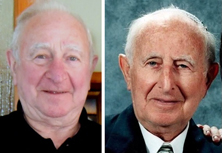
All Gordon’s doubts immediately seemed completely irrelevant. What is there to deliberate if I am looking at my grandfather’s photo, which is actually my uncle’s photo, Gordon’s father, who is believed to have been killed in 1941, 68 years ago!
I sent Herschel’s picture from Gordon to my children together with a question: “Who knows this man?”. The first one to reply was my youngest daughter, Yael, the granddaughter of Israel, Herschel’s brother. Her response says it all: “Say, dad, grandpa is not dead?”.
At that point I already had no doubt in my mind that my uncle Herschel was found. However, in order to be absolutely sure, I sent Gordon some photos that I had, one showing grandmother Beile with her sisters (Figure 1), one showing my father with Herschel and friends, and one in which Heschel is shown wearing a long leather coat (Figure 6). Gordon indicated that he intended to visit his father the coming weekend and to show him the pictures, so I figured that uncle Herschel should, of course, recognize himself and his mother.
The excitement in our family was enormous. My children, who grew up with the story of uncle Herschel who was killed in WWII, were stunned as well. My brother and sister soon joined the correspondence and, as the story unfolded, the subject became the “talk of the town” among all family members and close friends. We have always heard stories about family members who found each other after being separated for decades, but for us to find ourselves at the focus of such a reunion after almost seventy years, was beyond imagination!
Gordon Davidson (continues):
Well, after establishing the contact with Noah, there was just one shock after another, and to find out that some of father’s family had actually survived the war, was absolutely astonishing and beyond my wildest dreams! Not only had his brother and father survived the war, we actually had over seventy relatives living in Israel!
When I visited my father to give him the news, he was actually so shocked he was speechless! He just couldn’t believe it when I showed him photographs of himself, which Nahum had sent me from Israel. The only disappointment was that his brother hadn’t survived long enough to make it a perfect story. In fact, he said if his brother had still been alive, he would have immediately jumped on a plane and flown straight to Israel. As I further explained that he actually had two nephews and a niece with an extended family of around seventy relations, he was overcome with emotion and we immediately started planning a trip to meet them all.
The next stage was to break the news to my sister Margaret, in Australia, my brother, Michael who lives in the south coast of England, and my brother, Brian who lives in Ripon, which is also in England. I had compiled an email with the story so far and attached the photographs that Nahum had sent. I called them individually, and told them to pour themselves a strong drink and wait for my email to arrive without telling them what it was about. Well, their reactions were almost identical – they were completely “gobsmacked”! They just couldn’t believe what I had discovered and, like father, they were desperate to go to Israel and meet everyone.
The Reunion
During the period when the story unfolded, coincidentally, Nahum, his brother Baruch, and his sister Ester were planning a family meeting including all Israeli members, which was scheduled for November when Israel Dentelski’s memorial day was due. In light of the exciting developments, naturally everybody was anxious to meet the new family members as soon as possible; it was suggested we also invite the Davidsons to attend.
So, on 28 October 2009 Harry Davidson (then 86 years old) and his children Margaret, Mike, and Gordon, landed in Ben Gurion airport and were welcomed by Nahum and Noah. They stayed over a week during which they had several meetings with Nahum and Noah, in which Nahum and his newly found cousins tried to squeeze out of Harry as many details as possible about his past. Nahum drove the guests across the country giving them a grand tour of Israel including, of course, a visit to Israel Dentelski’s grave to pay tribute. Noah took them on a guided tour of the Yad Vashem museum.
The climax of the visit was a reunion meeting of the extended family that took place in a venue in Jerusalem, and which was extensively photographed and filmed. The attendees included the guests of honor, the Davidsons, and the Dentelski and Isman families, including children and grandchildren. At the focus of the meeting were presentations given by Nahum and Noah telling the life stories of Harry, Israel, and Guta, as well as how the reunion came to be, all of which is told herein.
Nahum recalls that, in one of his private conversations with his uncle Harry, after he told him details about the life of his brother Israel, Nahum’s father, Harry said (roughly): “All my life, after the war, I searched and tried to find out how my family was annihilated, because I thought their fate was similar to many other Jews during WWII. Now, to see this huge crowd, all of whom are my brother’s descendants, is beyond imagination”.
Gordon indicated that the trip they made to Israel was the most amazing journey he has ever made, and that they were so impressed with their new family and the state of Israel that they couldn’t wait to plan their next trip!
Nahum, Noah, and their spouses then visited Harry in Montrose in 2011 and Harry, Margaret, Mike, and Gordon visited Israel again in 2013.
Epilogue
Harry Davidson passed away in Montrose on 19 May 2014. Harry had not felt comfortable making the story public and his feelings were respected. Now, as Harry is no longer with us and it is the tenth anniversary of the reunion, all parties involved agreed that the story should be released. And, as Gordon summarized:
“It is an absolutely amazing story and thanks have to go to Noah’s mother for recording all the information in Yad Vashem and to JewishGen for maintaining their website.”
September 2020
Netanya, Israel
Editor’s Note:
From the Archives of the JewishGen Discussion Group, a message from Gordon Davidson, June 2, 2009:
I would just like to thank the JewishGen site for their fantastic work. Through them and the help of Israel Pickholz in particular I have managed to contact survivors’ relatives and discover what happened to direct relatives. I truly didn’t expect anything, but thanks to this site I am now in contact with family I never knew existed. Keep up the good work!
Gordon Davidson
Research Notes and Hints
Noah Isman enriched his success story by including sections written by his family members, Gordon Davidson and Nahum Dentelski.
Discovering the Pages of Testimony his mother had submitted to Yad Vashem many years ago was Noah’s first step towards his successful research and family connections. The Pages of Testimony also proved to be key to Gordon Davidson’s research.
The breakthrough came for Gordon and his father, Harry Davidson, when they searched on JewishGen for some of the family surnames Harry remembered from long ago. These names were listed on a number of JewishGen’s databases, giving the Davidson’s new avenues to research. You can search your surnames on JewishGen’s Unified Search.
Gordon and Harry found helpful information in Jack Kagan’s book, Novogrudok: the history of a Jewish shtetl, which is available in certain libraries and from booksellers. He also discovered the names of some family members listed in Tilford Bartman’s website, the Zabludow Memorial Website.
Noah discovered family burial records listed on the Hevra-Kadisha website.
For more information regarding Zabludow, see Chosen Pages from the Zabludow Yiskor Book on the JewishGen website.
